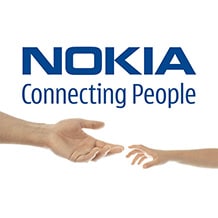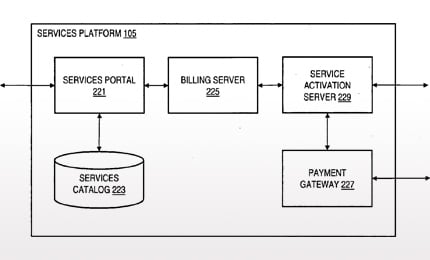A patent application authored by two senior Nokia executives shows how the handset manufacturer could generate revenues from the NFC phones it plans to introduce next year — without needing to get involved in mainstream mobile payments and without mobile network operators needing to invest in NFC SIMs or back office systems.

A patent application by Damien Balsan, Nokia‘s head of NFC business development Americas, and Ajay Bam, responsible for global product management of payments and shopping solutions at the handset manufacturer, has been published.
The patent application describes a service that uses NFC’s tag reading capabilities to make it easy for consumers to sign up for and manage a wide range of services. The system can also be used to deliver coupons and special offers in specified quantities at defined geographic locations.
The components of the system include bearer tags, user equipment, a services management platform, a network billing system, a payment gateway and a store front:
- Bearer tags. These could be NFC tags, contactless cards or barcodes and could be “embedded in, attached to, or printed on any of a variety of materials capable of supporting the tag (e.g. packaging material, a sticker, a poster, a card, etc) and would be used for “discovery, activation, accessing, modification, and set-up of one or more services, including services, applications, and content.”
- User equipment (UE). This is any device with a communications connection such as fixed terminal, mobile terminal, or portable terminal including desktop computers, laptop computers, handsets, stations, units, devices, multimedia tablets, internet nodes, communicators, personal digital assistants (PDAs), mobile phones, mobile communication devices, digital camera/camcorders, audio/video players, positioning devices, game devices, televisions, and/or the like, or any combination thereof.
- Services management platform. This is a trusted service manager (TSM) for tag reading applications that handles requests generated by the user’s device when it is used to read a tag. It supports discovering a service, selecting a service, activating a service, modifying a service and cancelling a service. This platform also includes several sub-modules which would each be responsible for managing services corresponding to particular bearer tags.
- Store front. The service management portal also contains a services portal, described as a store front in the patent document.
- Services catalog database. This is contained within the services portal and stores details of the individual services corresponding to each bearer tag.
- Payments gateway. The services management platform can also be connected via a payments gateway to existing billing systems provided by, for example, the users’ mobile network operator.
- Service activation system. This enables the service requested by the user to be delivered to them, once payment has been authorised.
How it works
When a consumer taps a tag, a request is sent to the service management platform. This identifies the service the consumer is requesting and, via the services portal, interacts with the database and billing system to determine user information and/or billing information (such as the relevant monthly fee, discount awarded, promotion on offer and product cost) associated with the tag the user has read.
The services portal then uses this information to generate a message requesting confirmation of the service management request from the user. On receipt of the user confirmation, the services portal directs the payment gateway to collect the fees associated with the request by, for example, interacting with the network billing system to collect payment via direct billing to the user’s phone bill or other operator-provided billing methods. One particularly interesting aspect of the patent application is that it refers only to operator-provided billing methods although there is no reason in theory why it could not also connect to other payments services.
After collecting the appropriate payment, the payment gateway sends the payment or, in some cases, verification of the payment to the services portal. The services portal then interacts with the service activation system to initiate activation or modification of a service according to the service management request.
This same system could then also be used to activate, modify, or otherwise manage existing services the user has purchased or subscribed to. Billing information could, the patent explains, be printed or displayed on the tag itself or the service could be configured to display the billing information on the user’s device when a tag is read.
Coupons and special offers
As well as enabling consumers to purchase or subscribe to services via bearer tags, the patent also describes how the system could be used to deliver special offers, discounts and coupons. These, the patent explains, can be limited to certain geographical areas by tying together both the service request and knowledge of the user’s current location gained via their mobile device. Other restrictions could also be put in place. A particular bearer tag could be tied to a particular device, for example. And a counter in a tag could be decremented each time it is read so that it can be used to delivery a maximum number of special offers.
Advantages
In this way, the patent application explains “a service that can be initiated quickly and billed through a single tap is likely to be more attractive to users, which can drive more users to the service”:
Traditionally, a user searches for and discovers services by, for instance, paging through lists of available services on a UE. This process can be complex and cumbersome (e.g. requires extensive typing on a mobile device), particularly when the UE, for example, is a device limited input capabilities (e.g. a handset with a numeric keypad). After finding and selecting a desired service, the user must then provide payment information. Like the selection process, the payment process can also be inconvenient and taxing. The complexity and difficulty of manager services using traditional methods may discourage users form using a service they might otherwise subscribe.
To address this problem, a mechanism, eg services management module, is introduced to detect input from a user for managing (e.g. activating or modifying) a service corresponding to a bearer tag. In exemplary embodiments, reading the service information from the bearer tag quickly identifies the requested service. A request is generated to manage the service according to the service information from the bearer tag, and is forwarded to the services platform for processing according to a billing arrangement or a predetermined billing arrangement with, for instance, the carrier. For example, the billing arrangement is effected using mechanisms such as premium short message service (PSMS), wireless application protocol (WAP) billing service. The billing arrangement also may be configured to bill the user periodically (e.g. one a month) without additional action from the user.
Moreover, the process of managing a service may occur automatically, thereby enabling a user to initiate a service by, for instance, simply tapping or bringing a UE close to a bearer tag associated with the service.
“The described processes and arrangement advantageously, according to certain embodiments, provide a rapid and convenient mechanism for a user to identify and subscribe to services, ” the document explains.

NFC World asked Nokia for further information on the patent application and its implications. The handset maker declined to go into further detail: “As a global leader in wireless innovation, Nokia files around 1,000 patent applications each year and now has a portfolio of around 11,000 patent families,” a spokesman told NFC World. “NFC has been an important topic for Nokia for some time and we have been active in the field. However, we cannot comment on whether or when inventions described in patent applications may eventually appear in products.”
Readers can read and download the full patent application in PDF format here.
Next: Visit the NFCW Expo to find new suppliers and solutions
HI,
we develope some application based on NFC Nokia 6212 for HomeCare and Order entry for customer experience.
It's very interesting reading these articles.
Thank you